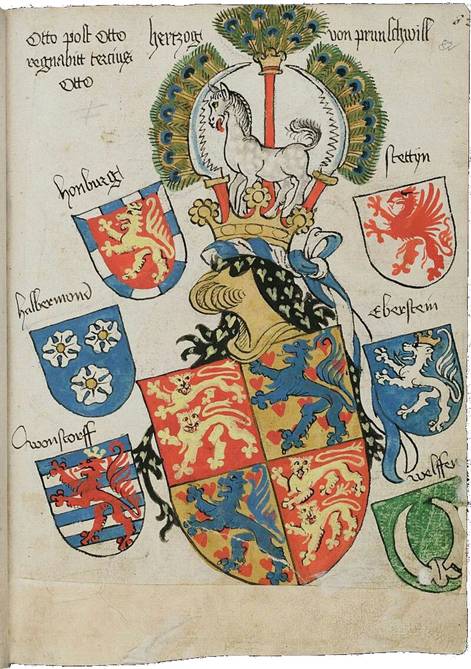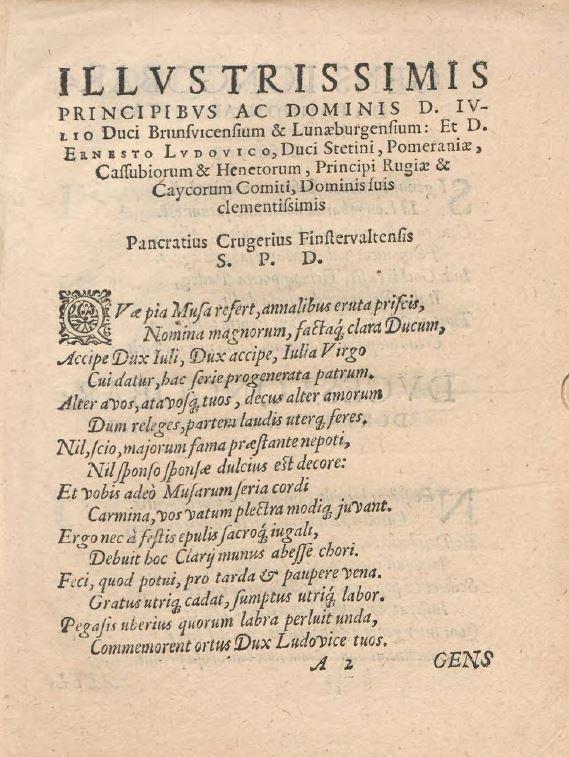The Piast Inheritance of the House of Brunswick-Wolfenbüttel
Building upon the foundation laid in Article 1: Brunswick Being the Only Probable Successor of the Piasts, we now explore additional heraldic and historical data that support the rightful claim of the House of Brunswick-Wolfenbüttel to the Piast legacy. This continuation draws attention to powerful visual and genealogical evidence, reinforcing their role as lawful inheritors not only in title but also in territorial and cultural influence.
Heraldic Continuity in Stettin and Pomerania
One of the most vivid confirmations of Brunswick-Wolfenbüttel authority in the East is found in a heraldic panel from Stettin. This artwork includes a central shield labeled “Herzog von…” in Gothic script, surrounded by six vassal arms. The central imagery features elements consistent with Welf heraldry—rampant lions, ducal coronets, and distinct coloration—that reflect a sustained claim to Eastern dominions.

Caption: This Stettin heraldic panel visually places Brunswick at the center of noble authority over Pomerania and surrounding vassals. The six surrounding shields likely represent subordinate houses or territorial allegiances. One of the clearest identifiers is the green-shielded horn device attributed to the Welfen, evoking the ceremonial horns sometimes seen in Brunswick representations. The presence of multiple regionally linked coats of arms around a central Brunswick-Welf device suggests feudal oversight or respected dominion at the time of composition.
These devices are more than decorative—they signal feudal oversight, historical entitlements, and continuity of governance long after titular claims had nominally ended. Such visual cues act as silent witnesses to long-forgotten sovereign structures that remained respected within the regional nobility.
Latin Inscription and Dynastic Echoes
Accompanying the heraldic shields is a Latin inscription invoking the duke’s dominion over both German and Slavic lands. The script identifies him as “Herzog von…” followed by phrases indicating regional rule beyond Wolfenbüttel, potentially encompassing areas of the former Piast realm.

Caption with Translation:
Dedication Title Translation:
ILLVSTRISSIMIS PRINCIPIBVS AC DOMINIS
D. IVLIO Duci Brunsvicensium & Lunaburgensium
Et D. ERNESTO LVDOVICO, Duci Stettini, Pomeraniae, Cassubiorum & Henetorum, Principi Rugiae & Caycorum Comiti, Dominis suis clementissimis
Tłumaczenie:
To the Most Illustrious Princes and Lords,
Lord Julius, Duke of Brunswick and Lüneburg,
And Lord Ernest Ludovicus (Ernst Ludwig), Duke of Stettin, Pomerania, of the Kashubians and Wends,
Prince of Rügen and Count of the Circipani,
their most gracious lords…
✍️ Author: Pancratius Crugerius Finsterwaltenis S. P. D. — A humanist-style writer sending greetings to these dukes.
📜 Poem Opening Translation:
Vae pia Musa refert, amabilibus eruta priscis, Nomina magnorum, factaque clara Ducum…
The faithful Muse brings forth, drawn from lovable ancient times, the names of great ones, and the famed deeds of the Dukes…
This confirms a ceremonial and potentially dynastic alliance between:
- Duke Julius of Brunswick-Lüneburg, and
- Duke Ernst Ludwig of Pomerania-Stettin
It underscores cultural and political collaboration across German and Slavic courts and reinforces dynastic resonance between Welfs and Griffins.
Lineage from Henry the Younger and Duke Julius
In Article 1, we established that Henry V the Younger of Brunswick laid the dynastic groundwork, and his descendant Duke Julius fortified this claim through his marriage to Hedwig of Brandenburg. This alliance tied Brunswick to the Piast blood through Brandenburg’s inheritance of Silesian and Ruthenian legacies. As discussed in the Watchman article on Galicia and Lodomeria, these bloodlines held lawful inheritance rights under both Polish and Russian succession norms.
Julius’s progeny continued intermarrying with Eastern European royalty, ensuring that the Welf-Brunswick line absorbed legal, spiritual, and political rights from the fading Piast and Jagiellonian traditions.
Early Noble Recognition in Pomerania and Poland
Among the more symbolic yet fascinating artifacts of this lineage is the documented Wappenverbesserung (heraldic improvement) granted by King Sigismund of Poland in 1570 to a noble house from Braunschweig, residing in Schlesien and Pommern. While not definitive, this record demonstrates that even side branches of the House of Brunswick retained social and noble standing across Eastern realms.
“Ein wahrscheinlich aus der Stadt Braunschweig stammendes Geschlecht, das aber bereits im XVI Jahrhundert in Schlesien (Polen) und Pommern (Patriziat von Stettin) vorkommt, 1570 vom König Sigismund von Polen einen Adelsbrief mit Wappenverbesserung, Bestätigung des Adels aber 1648 und 1668 erhielt.”
Such confirmations in 1648 and 1668 suggest continued respect for Brunswick-derived families within the Eastern noble register.
 From “Die Polnischen Stammwappen, ihre Gelchichte und ihre Sagen”
From “Die Polnischen Stammwappen, ihre Gelchichte und ihre Sagen”
Caption: The Polish heraldic certificate, granting noble status and symbolic upgrades to a Brunswick-origin family living in Schlesien and Pommern, affirms their presence in the Pomeranian-Polish patriziat. Though centuries removed from the central Welf line, this recognition lends continuity to claims stretching into Slavic lands.
While this piece should not be overstated, it offers a valuable supporting detail, echoing the broader dynastic claims rooted in earlier imperial marriages and feudal assignments.
Conclusion: Legitimacy Reaffirmed Through Symbol and Blood
Whereas modern scholarship too often dismisses dynastic continuities in favor of revolutionary breakpoints, the case of the House of Brunswick-Wolfenbüttel reminds us that many noble transitions were gradual, lawful, and recorded in both symbolic and genealogical terms.
This article has deepened the case for Brunswick’s inheritance of the Piast mantle—linking the visual authority in Stettin with bloodlines stretching from Henry the Younger to Julius and into the courts of Brandenburg, Ruthenia, and Poland. Combined with the assertions made in Article 1, the path of succession becomes not only plausible but historically compelling.
Preview of Article 3:
The next installment in this series will examine the cadet line stationed in Mecklenburg, tracing its documented role in noble, pastoral, and advisory duties. From Ritteramt Groß Raden to Ludwigslust, their survival through the extinction of elder branches positions them as natural successors—carrying forward the torch of Brunswick legitimacy into the modern age.
